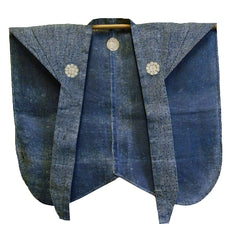A Katazome Dyed Hemp Child's Historical Garment: Kataginu
ca. early twentieth century
21" x 22", 53.25 cm x 56 cm
As may be easily recognized from the accompanying photos of this indigo, katazome dyed hemp kataginu, it is the top half of a kamishimo, the traditional costume of samurai and courtiers in Edo Japan. Along with a hakama, a kind of loose fitting, pleated skirt-like trousers, the kataginu would have been worn over a kimono.
This is a small scale kataginu and judging from its lack of wear and its crisp, clear hemp cloth, this was probably not made and worn during the Edo period (1603-1868), but rather it was probably used in some kind of historical pageant or parade, as a costume.
True, the dyeing is expert and just as it would have been during Edo, but the overall quality of the garment feels to date to about 100 years ago or less.
The small repeat pattern is of the type that was popular during the Edo period and is called Edo komon.
A beautifully fashioned, traditional Japanese garment.

